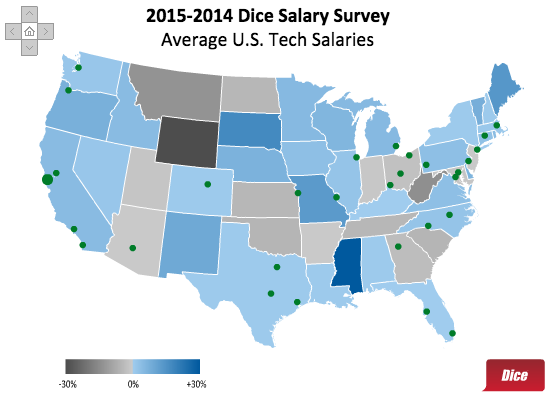The average technology professional made $89,450 in 2014, according to the latest Dice salary survey. That’s an increase of 2 percent over 2013, and yet another sign of the technology industry’s robust health.
When it comes to salaries, however, not all states and cities are created equal. Those tech pros living and working in Silicon Valley are the highest-paid in the country, with an average annual salary of $112,610—but that salary grew only 4 percent year-over-year, lagging behind cities such as Portland (up 9 percent year-over-year, to $91,556) and Seattle (up 5 percent, to $99,423).
Click here to find technology jobs.
As you click around on the map above, note how salary growth is particularly strong in parts of the West, the Northeast, and the South, while remaining stagnant (and even regressing) in some middle states. If anything, the map reinforces what many tech pros have known for years: that more cities and regions are becoming hubs of innovation. Expect that growth to likely continue through 2015.
Dice Salary Survey Methodology
The 2014 Dice Salary Survey was administered online, with 23,470 employed technology professionals responding between September 29 and November 26, 2014. Respondents were invited to participate in the survey through a notification on the Dice site and registered technology professionals were sent an email invitation. A cookie methodology was used to ensure that there was no duplication of responses between or within the various sample groups and duplicate responses from a single email address were removed. The Dice Salary Survey was adjusted for inflation in 2014: Technology professionals earning salaries of $250,000 and above were not automatically eliminated from the survey if they met other criteria.
Upload Your ResumeEmployers want candidates like you. Upload your resume. Show them you're awesome.



